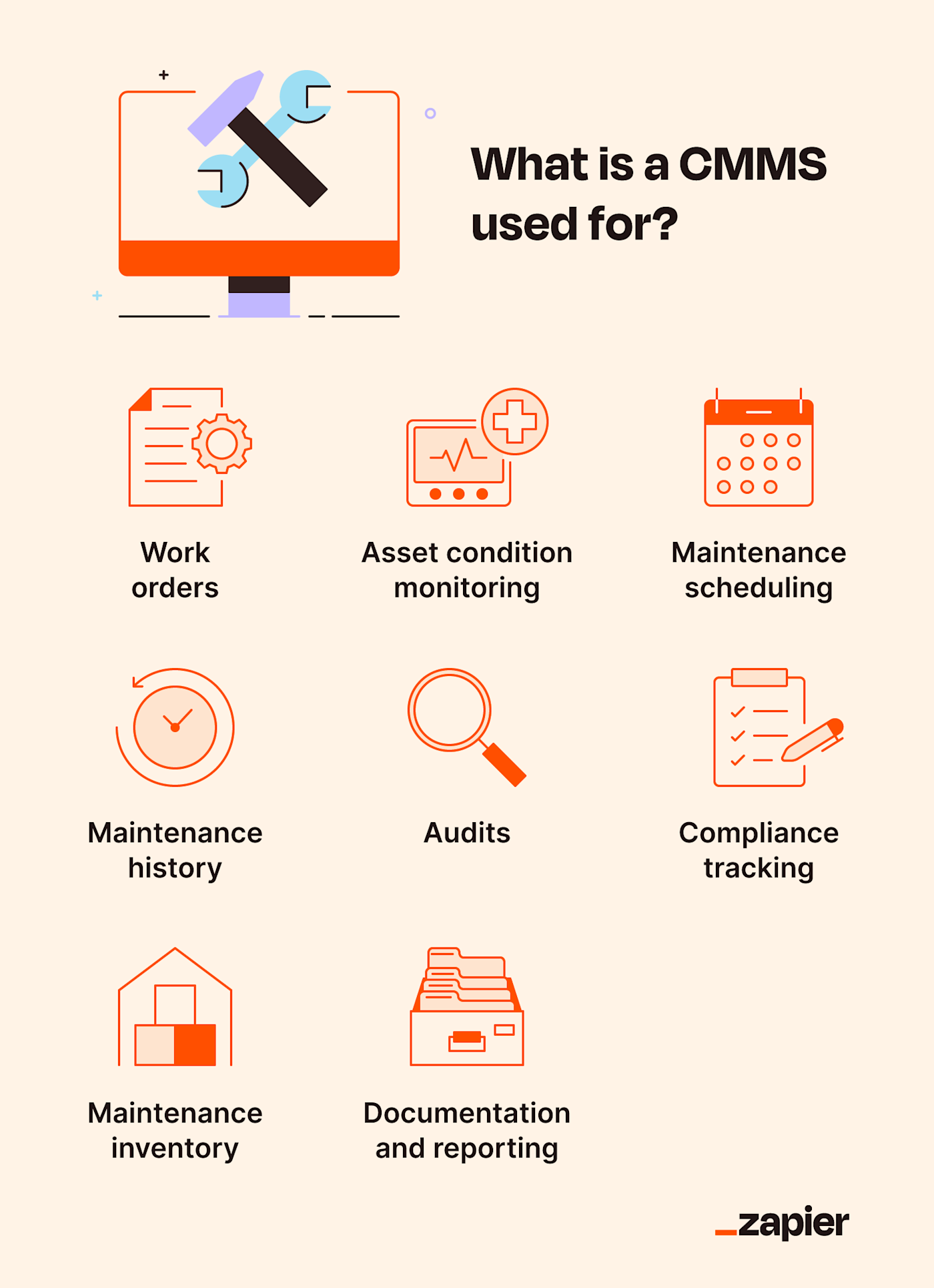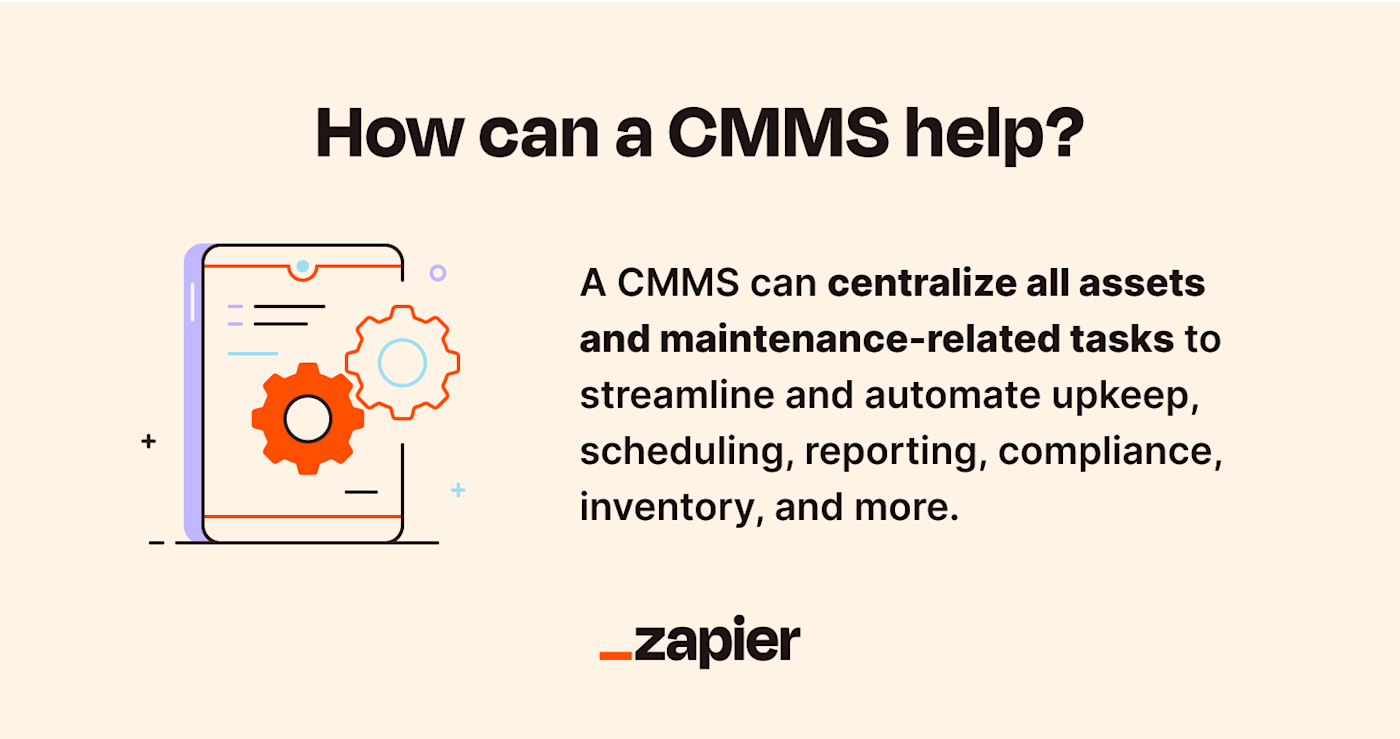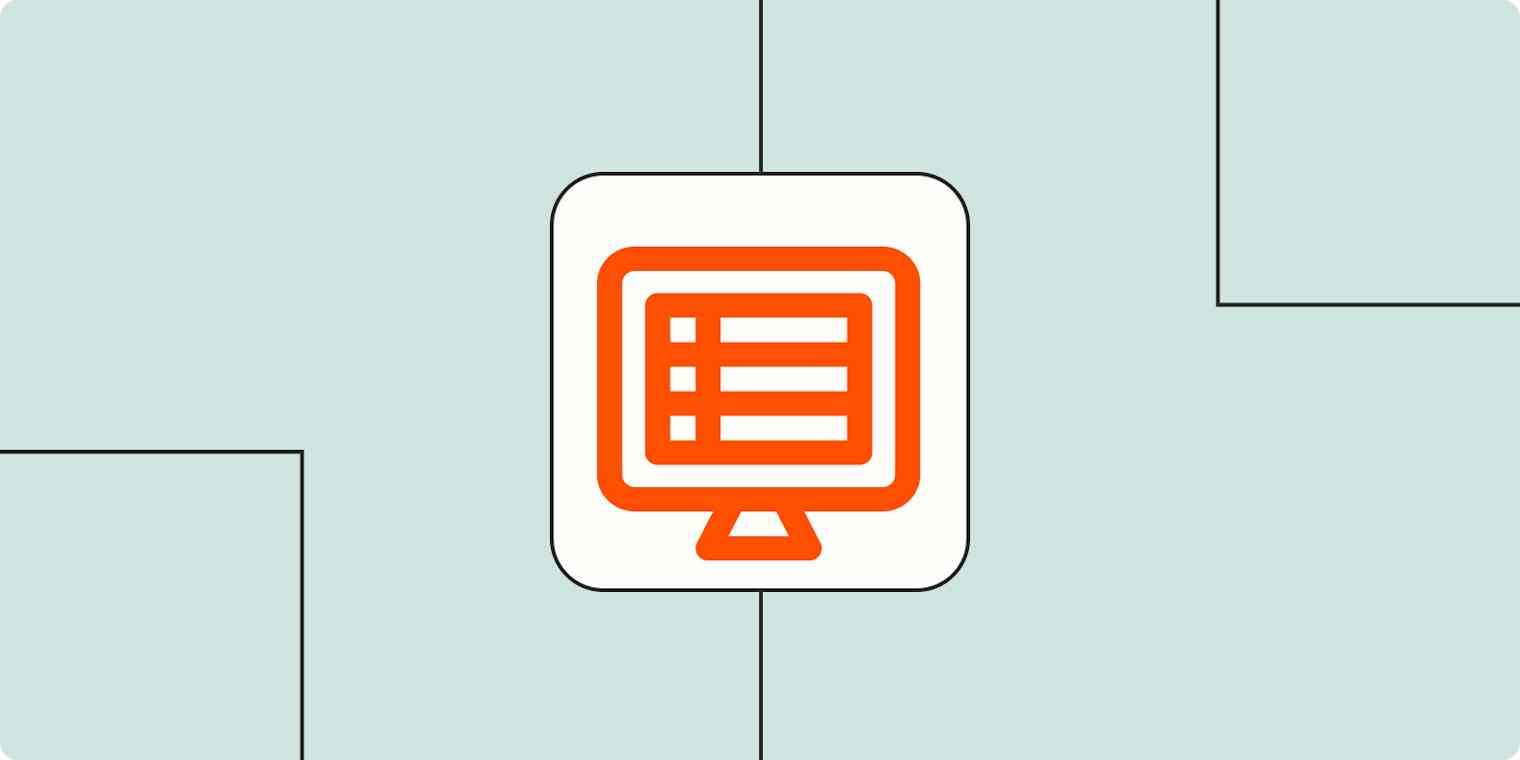Like many kids, I was obsessed with LEGO bricks (as I'm legally required to call them) for most of my childhood. I had a big plastic bin holding all the blocky creations that I'd orchestrate adventures for on my bedroom floor. Sometimes, those little trucks, planes, robots, spaceships, castles, and buildings would get damaged, losing pieces along the way.
At the time, I could keep a mental inventory of each creation's blueprint and then handpick the pieces I needed to repair or upgrade them from the bits and pieces in my bin. But what really would have upped my LEGO brick game was a centralized, digitized dashboard. A CMMS, or computer maintenance management system, is basically that, but on a massive, much less entertaining scale.
Table of contents:
Computerized maintenance management system (CMMS) definition
A computerized maintenance management system, or CMMS for short, is a digital hub for organizing, tracking, and scheduling operations and service for physical assets and infrastructure. CMMS software manages assets like:
Manufacturing equipment
Maintenance personnel
Maintenance, repair, and operations (MRO) inventory
Delivery vehicles and fleets
Production plants
Storage facilities
Broader physical asset infrastructure
A CMMS can help maintenance managers stay on top of regular maintenance, work orders, asset life cycles, reporting, asset conditions and inventory, compliance progress, and much more.
How a CMMS is used

A CMMS stores data about everything related to physical infrastructure and assets, including information about individual vehicles, pieces of equipment, schedules, past and upcoming work orders, and historical data. Users then use this database to do things like schedule maintenance, handle incoming work orders, monitor equipment health in real time, log maintenance issues, connect plants and warehouses with field operators, communicate with external partners, and update documentation for compliance purposes.
The short version: CMMSs are used to streamline physical infrastructure processes by improving the accuracy of information, collecting data in real time, and connecting separate teams and operators.
Who uses CMMS software?
CMMSs are used by, in short, any maintenance-related stakeholders in a business or organization with many assets and complex physical infrastructure. CMMS software helps these teams simplify, consolidate, and automate maintenance procedures so they can preserve their assets, reduce downtime, and enhance safety. Stakeholders like these might include:
Maintenance managers
Maintenance and repair technicians
Inventory managers
IT personnel
Field operators
Facility or plant managers
Reliability engineers
Production teams
Senior executives
Safety auditors
Third-party contractors
This isn't an exhaustive list by any means, but it should give you a top-to-bottom look at the types of people who might be involved with a CMMS at any level. From installation and rollout to training and system maintenance to using the software itself to updating it from the field, there are many roles with different access needs.
CMMS benefits

For businesses and organizations that manage a complex physical infrastructure, a CMMS comes with some incredibly useful benefits.
More uptime
One of the most significant benefits of a CMMS is that the improved efficiency of maintenance cycles leads to improved uptime, keeping high-cost assets more productive more of the time.
Centralized database
All data related to infrastructure management is consolidated into a single, accessible database—no sifting through separate spreadsheets, files, documents, or solutions.
Single source of truth
A CMMS can update records and data related to all assets in real time, giving all stakeholders one access point for reliable, accurate information.
Automation capabilities
With all relevant information collected into one digital hub, users can start automating things like recurring tasks, data management, reporting, and much more.
Transparency
With real-time reporting and centralized records, there's never any question about when an action was taken, when an action needs to be taken, where assets are located, or what the status of an ongoing process is.
Integration of internal and external operations
A CMMS can link internal operators with external ones, keeping both localized and field teams connected to external partners to keep complex processes and partnerships running smoothly and cost-effectively.
Reliable maintenance scheduling
With up-to-date maintenance records and asset health readily available, managers can automatically schedule regular maintenance checks and adjust them when unexpected repairs come up.
Simplified compliance
Compliance stakeholders can review records, set reminders, automatically update logs, and customize reporting based on the unique parameters of their audit requirements. This helps them stay on top of audit processes with less stress, better accuracy, and minimal disruption to work operations.
Improved safety
A well-maintained physical infrastructure is a safe physical infrastructure. With improved auditing and more reliable maintenance schedules, team members who rely on these assets have more peace of mind that they're in optimally safe working order.
CMMS vs. EAM
CMMS and EAM sometimes get used interchangeably, but the key difference between the two systems is scope. While a CMMS is designed specifically to manage maintenance-related tasks, personnel, history, and inventory, EAM systems—that's enterprise asset management—take it one step further, expanding asset management for various asset types across an enterprise.
EAM enables asset managers to:
Monitor assets for their entire life cycle, even before they're acquired
Manage multiple sites and separate businesses
Schedule work beyond the scope of maintenance
Manage supply chains
Do anything they would do with a CMMS
The two do similar things, but since EAM does much more than a CMMS can, it can be considered an upgraded solution once a business's asset management needs grow beyond maintenance.
CMMS software features
All CMMS software isn't the same, and the things you need your CMMS solution to do may not align with the strengths of every offering. Here are some common CMMS features to look for:
Physical asset management: The central capability of a CMMS is a comprehensive, accessible log of assets and their maintenance histories and schedules.
Work order management: Another important feature of a CMMS is the ability to easily create, edit, respond to, and log work orders.
Automated inventory management: A CMMS can be used to monitor maintenance-related inventory and to automate notifications for low stock and order more.
Maintenance scheduling: With complete maintenance histories and scheduling capabilities, CMMSs can be set to tailor regular maintenance schedules to the needs of individual assets.
Reporting and record-keeping: Every asset and action can be logged within the CMMS and easily recalled or pulled into custom reports.
Audit dashboards: Audit dashboards help maintenance managers maintain documentation and timelines to keep up with audits.
Integrations: Sophisticated CMMS software can integrate with other applications specific to individual needs and workflows.
Real-time monitoring: All assets can be monitored within the CMMS to show real-time asset conditions, taking the guesswork out of maintenance planning.
External partner support: External partners can be integrated into the CMMS to streamline cross-organizational collaboration.
Mobile utility: To support team members in the field, a CMMS can be accessed and updated via mobile application.
Security: Quality CMMS software keeps all sensitive data secure.
This isn't an exhaustive list of the features you'll find in every CMMS software option, but this should help set expectations for the kinds of utility you can look for.
Industries that commonly use CMMSs
Traditionally, CMMSs have been the go-to solution for manufacturing industries because they require so many assets that need maintenance, safety compliance, and work order processing. But over recent years, other less obvious industries have started adopting them. Here are some common examples:
Manufacturing
Oil and gas extraction
Clean energy production
Mining
Food and beverage production
Scientific research laboratories
Pharmaceutical development
Product distribution
Facilities management
How to know if you need a CMMS

If you're already considering implementing a CMMS, there's a good chance your business would get a lot of value from a system like a CMMS, even if your industry isn't one of the ones noted above. To help make the decision, ask yourself these questions about your business:
Does it rely on a large number of physical assets?
Does it require regular infrastructure maintenance?
Does it manufacture or produce a large number of physical products?
Does it involve regular work order processing?
Is physical safety an important factor in your facility?
Is compliance complex?
Could automated scheduling improve workflows and maintenance significantly?
If you found yourself answering "yes" to most of these, you may want to consider a CMMS—or even an EAM if there's even more complexity involved than maintenance.
CMMS cost considerations
Costs for CMMS software can range widely, depending on an even wider range of cost factors.
Scope of service
Since CMMSs can be scaled to meet individualized feature needs, this can be one of the biggest factors in software costs. For smaller businesses, infrastructure with moderate complexity, or teams that plan to supplement the CMMS with other applications, lower-tier software could be plenty.
Meanwhile, more robust offerings can ramp up costs pretty quickly, but the added utility could potentially lead to huge cost savings pretty quickly.
Scale of business
The scale of your business could also impact costs. If you're looking to implement a CMMS for a big team with many users, lots of assets, and dynamic permissions and access needs, you can expect to see that complexity reflected in the product costs.
Implementation costs
Several elements of implementation could affect costs.
Setup: If your team doesn't have the training, skills, or experience to implement it internally, you may have to pay the provider for implementation service.
Training: You may have to pay for additional training and product support to help ease the transition or ensure the rollout runs smoothly.
Integration: You may need to pay to upgrade hardware or cover separate integration fees to link the software with your existing applications.
Uptime: If the rollout is complex, there could be temporary downtime or losses in productivity that the software will soon more than make up for.
Quality and reputation of the provider
Like any other software type, CMMS costs can vary by provider. There are plenty of options, and you may pay a premium for bigger-name providers with well-established reputations beyond the CMMS industry. That said, you may also be able to keep costs low by picking software from newer or smaller companies, but you should always do the usual due diligence in vetting reviews and available features.
Tips for choosing the best CMMS software for your business
Before you make your CMMS software selection, it may be worthwhile to consider some of these questions about your potential options:
Integration complexity: How easy will it be to integrate the software into existing workflows?
Integration capability: Is your existing team capable of integrating the solution?
Available features: Which common CMMS features are most important to your unique needs?
User experience: What's the software's user experience like—is it intuitive and responsive enough for seamless onboarding?
Mobile app availability: Is a mobile app important, and if so, does the CMMS have a mobile version?
Reporting and forecasting capabilities: What sort of maintenance reporting and forecasting needs does your team have, and can the software support those needs?
Automation features: Does the software have robust automation capabilities?
Picking the right computer maintenance management system is important; the last thing you want is to find you need to roll back so you can integrate a different CMMS product down the road. These systems aren't LEGO blocks, after all—you can't just knock them down and reassemble the pieces into the one you want.
Whichever software you choose, consider that Zapier integrates with thousands of apps to bring the power of no-code automation to virtually any workflow.
Zapier is the leader in workflow automation—integrating with 6,000+ apps from partners like Google, Salesforce, and Microsoft. Use interfaces, data tables, and logic to build secure, automated systems for your business-critical workflows across your organization's technology stack. Learn more.
CMMS frequently asked questions
What is a CMMS used for?
A CMMS is used for managing a business or organization's maintenance needs. Also called computer maintenance management systems, they help maintenance managers track the condition of assets like vehicles, machinery, and equipment so they can streamline maintenance scheduling, work order processing, compliance, and other tasks related to usage and upkeep.
Is CMMS the same as an ERP?
A CMMS does some of the things an ERP does, but the two are different. Computer maintenance management systems are used specifically for maintenance-related tasks and records, like MRO inventory, equipment, vehicles, and facilities. Meanwhile, enterprise resource planning solutions are more broadly used for managing data, tasks, inventory, and personnel across departments. ERPs may include some maintenance-related modules, but they have much wider use cases and less robust maintenance-related features.
What is an example of a CMMS?
An example of a CMMS is a software solution that allows a maintenance manager to oversee the maintenance histories and real-time conditions of assets and then automate tasks like maintenance scheduling, inventorying, work order fulfillment, and auditing. Some of the more common products include MaintainX, eMaint, Fiix, and UpKeep.
Related reading:






